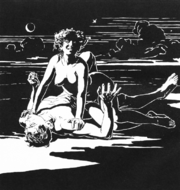
Wurdulac, also spelled wurdalak, verdilak or vurdulak, is a kind of vampire in the Slavic folklore mythology. Some Western sources define it as a type of "Russian vampire" that must consume the blood of its loved ones and convert its whole family.[1] This notion is based apparently on Alexey K. Tolstoy's novella The Family of the Vourdalak, telling the story of one such Slavic family.
In Russia the common name for vampire (or wurdulac) is upyr (Russian: упырь). Nowadays the three terms are regarded as synonymous, but in 19th century they were seen as separate, although similar entities. The Russian upyr was said to be a former witch, werewolf or a particularly nasty sinner who had been excommunicated from the church. In Ukraine the upyri were also feared as the vampires who could bring about droughts and epidemics.[2]
In Russian language the word wurdulac (Russian: вурдалак) first appeared in early 19th century, and became common due to Alexander Pushkin's 1836 poem of the same name, part of the Songs of the Western Slavs cycle. It is the corrupt form of the West Slavic word [volkodlak] Error: {{Lang}}: unrecognized variant: learn (help) (Russian: волкодлак), meaning literally 'wolf-fur' or 'wolf-hide', denoting someone "wearing" a wolf's skin, a werewolf.[3] Other sources suggest that Pushkin borrowed and adapted the word from Lord Byron's "The Giaour", which contains a footnote claiming that the Greek word for a vampire is "Vardoulacha". This in itself is a corruption of vrykolakas, which does come from the Slavic vukodlak.[4]
- ^ Bennett, Adelaide (2015). Global Legends and Lore: Vampires and Werewolves Around the World. Mason Crest.
- ^ Levkiyevskaya, E. Упырь. Mify russkogo naroda Мифы русского народа [Russian Myths]. Астрель, Аст. ISBN 5-271-00676-X.
- ^ "Krylov's Russian Etymological dictionary". Slovopedia.
- ^ Butler, Francis (2005). "Russian "vurdalak" 'vampire' and Related Forms in Slavic". Journal of Slavic Linguistics. 13 (2): 237–250. ISSN 1068-2090.